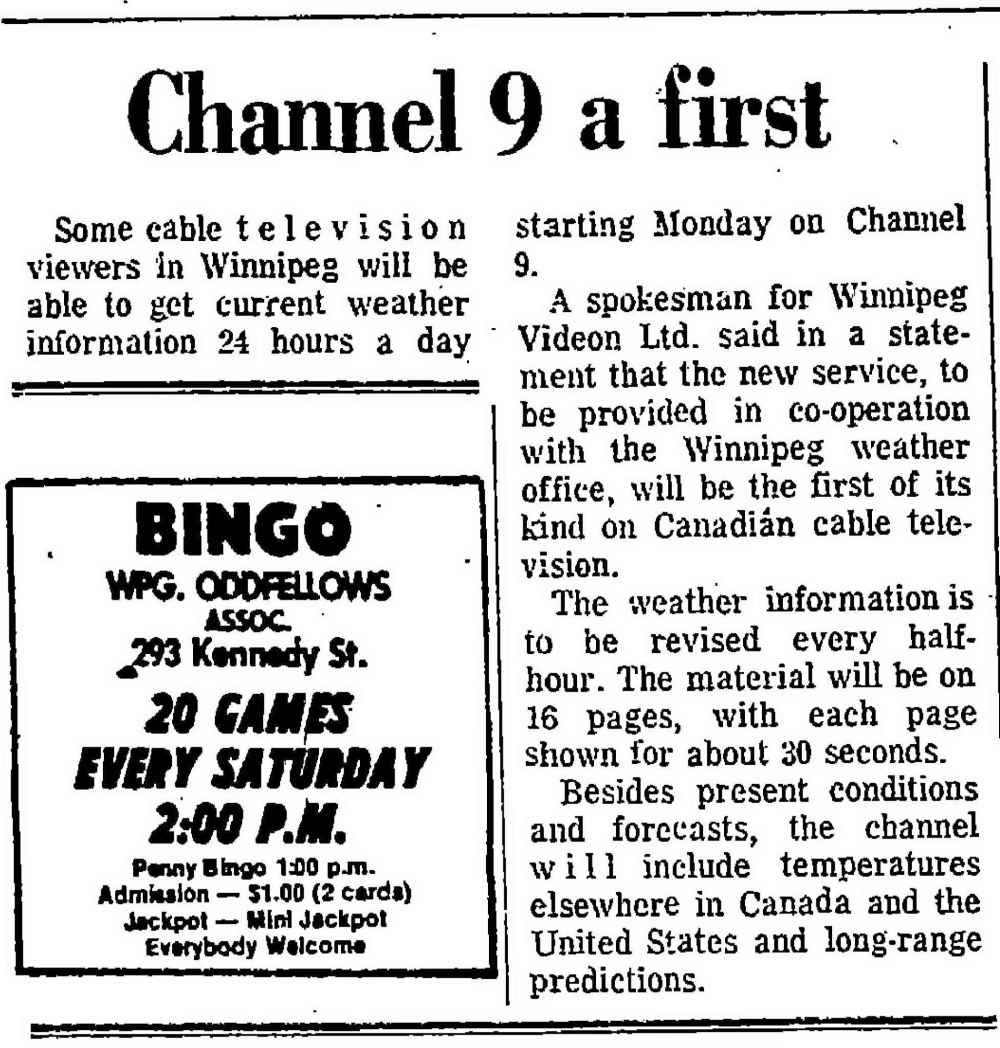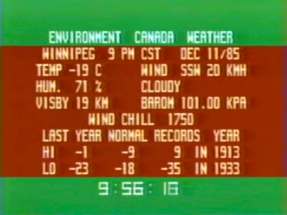Sunburned into our TVs Winnipeg needed a weather channel to know which way the wind blew
Read this article for free:
or
Already have an account? Log in here »
To continue reading, please subscribe:
Monthly Digital Subscription
$0 for the first 4 weeks*
- Enjoy unlimited reading on winnipegfreepress.com
- Read the E-Edition, our digital replica newspaper
- Access News Break, our award-winning app
- Play interactive puzzles
*No charge for 4 weeks then price increases to the regular rate of $19.00 plus GST every four weeks. Offer available to new and qualified returning subscribers only. Cancel any time.
Monthly Digital Subscription
$4.75/week*
- Enjoy unlimited reading on winnipegfreepress.com
- Read the E-Edition, our digital replica newspaper
- Access News Break, our award-winning app
- Play interactive puzzles
*Billed as $19 plus GST every four weeks. Cancel any time.
To continue reading, please subscribe:
Add Free Press access to your Brandon Sun subscription for only an additional
$1 for the first 4 weeks*
*Your next subscription payment will increase by $1.00 and you will be charged $16.99 plus GST for four weeks. After four weeks, your payment will increase to $23.99 plus GST every four weeks.
Read unlimited articles for free today:
or
Already have an account? Log in here »
Hey there, time traveller!
This article was published 13/08/2018 (2679 days ago), so information in it may no longer be current.
Man, Winnipeggers really loved the weather channel.
You may recall a column I wrote a couple weeks ago about Weather Channel Winnipeg, a live, online re-creation of the classic Videon-era Environment Canada weather channel. The replica was created by Brandon Martel and Craig Midwinter, a pair of 30-something software developers who, like so many of us, grew up with the weather channel on in the background.
As they quickly learned, Martel and Midwinter are not alone in their fondness for the original weather channel. Their project stirred up memories for many Winnipeggers — including Gary Krushen, the engineer who designed the original digital display for Videon back in 1975.
https://www.youtube.com/watch?v=wVUeZhkMkCA
Krushen, 67, emailed me shortly after my column ran. Obviously, I seized upon the opportunity to ask him about the genesis of your favourite channel and mine.
Let’s go back to 1973, when Krushen started his career as a special services engineer at Videon as a fresh-faced 22-year-old. Videon had a weather channel at that time, but it was in need of a serious upgrade.

The original system was located at Videon’s antenna site, several kilometres west of St. Norbert — which was less than optimal. “Often the weather conditions in a field outside of the city were quite a bit different from what they actually were for us inside the city,” Krushen explains.
As for the original display, well, it had its issues.
“It consisted of a row of weather instruments, arranged in a slight arc. Above these displays was a black-and-white TV camera with a pair of floodlights on either side,” Krushen recalls. “Now, I should point out that this was late-‘60s technology. They needed a lot of light. Then there was a mirror that panned across the gauges. It was a very primitive system and, on air, it looked like it. It wasn’t reliable. The light bulbs were forever burning out.”
The setup also came with an unexpected element of terror.
“Many people can remember these absolutely massive insects crawling across the gauges. The gauges were about three or four inches — but remember, when this was displayed on somebody’s home TV set, they were whatever size the screen is. So, what starts as three inches might be many times that.”
Krushen and his team from Videon approached Environment Canada about a partnership to develop a digital system.

“They, of course, had a mandate of getting weather information out to the public, so they were very receptive to the idea of doing something with us. I met with their staff on a few occasions and we hashed out what we’d like to see and how we could do it. Particularly their IT staff — they put a lot of work into the development of the software.”
The new and improved weather channel made its debut on channel 9 on Dec. 8, 1975. A Free Press brief touted it as the first of its kind on Canadian cable television.
“The vast majority was very positive,” Krushen says of the response. “There were a few people who didn’t like change, but once it was up and running, I think even the naysayers were quite delighted with it.”
The look of the digital display remained virtually unchanged until the end of the original channel’s run on Sept. 1, 1999: a footer and header band, with data pages in between. The main part of the display required economical forecasts: eight lines by 32 characters per page, with a maximum of 16 pages. (Sometimes abbreviations were necessary. Remember “frzg drzl” anyone?) Each page was displayed for 30 seconds.

“They wanted the local weather and forecast to be predominant. So, Page 1 was always Winnipeg weather, and Page 2 was the Winnipeg forecast. Then it might go off to Eastern Canada weather, Western Canada weather, U.S. weather and then back,” Krushen says.
“One of the things we discovered very quickly, say you were looking at Eastern Canada weather and it suddenly switched to Western Canada weather. People were frustrated to realize it had suddenly changed.”
The solution? “We had the pages alternate between red and blue.”
Those now-iconic shades of bright red and dark blue were chosen deliberately. “There were still a lot of black-and-white television sets out there in the mid-‘70s,” Krushen explains. “Blue has a very low luminance, or brightness level. Red is much higher. So even in black and white, you could tell when this transition had taken place from one page to another.”
Still, the colour-coding was hard on the CRT technology that TVs of the day used. “There were many TVs around the city with Environment Canada Weather burned in, so you could read it with the television turned off,” Krushen says with a laugh.

Videon ended up having to warn subscribers about leaving it on, which, of course, they were. Channel 9 had become a destination for people, especially with the addition of music a few years later.
And people had opinions about it. If the clock was off — particularly when it was time to spring forward or fall back to adjust for daylight savings time — Videon would get phone calls. “Any changes at all generated complaints,” Krushen says. (Winnipeggers gonna Winnipegger.)
Krushen marvels at “how popular it was for something relatively simple.” He suspects convenience was part of it.
“I think it’s just the fact you could go to that location and get the information that you wanted within one minute. And, of course, you didn’t have to do anything on a computer. Now, anyone under 30 has grown up with the Internet and modern communications, it wouldn’t have the same effect.”
As for Martel and Midwinter’s loving re-creation of the channel he designed, Krushen says he’s not surprised by the positive response it has garnered. “I’m really not,” he says.
“I’m actually quite gratified that it’s had so much staying power.”
jen.zoratti@freepress.mb.ca Twitter: @JenZoratti

Jen Zoratti is a Winnipeg Free Press columnist and author of the newsletter, NEXT, a weekly look towards a post-pandemic future.
Our newsroom depends on a growing audience of readers to power our journalism. If you are not a paid reader, please consider becoming a subscriber.
Our newsroom depends on its audience of readers to power our journalism. Thank you for your support.









